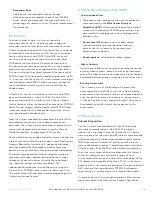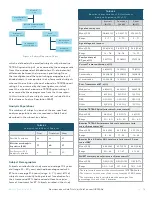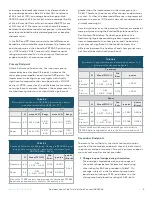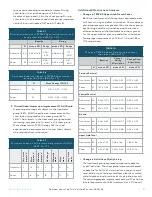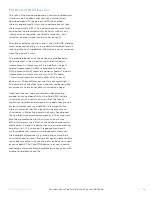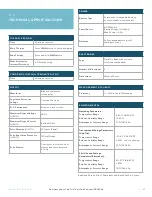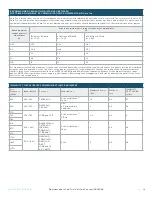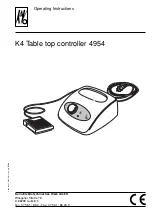
27
Questions about Cala Trio? Visit CalaTrio.com/HCPFAQs
LBL-5122 Rev C NOV 2019
GUIDANCE AND MANUFACTURER'S DECLARATION - ELECTROMAGNETIC IMMUNITY
IMMUNITY TEST
IEC 60601 TEST LEVEL
COMPLIANCE LEVEL
ELECTROMAGNETIC
ENVIRONMENT GUIDANCE
Voltage dips, short
interruptions and
voltage variations
on power supply
input lines IEC
61000-4-11
Voltage Dips 30% reduction, 25/30 periods
At 0°
Voltage Dips 30% reduction, 25/30 periods
At 0°
Mains power quality
should be that of a typical
commercial or hospital
environment. If the user of
Cala Trio requires continued
operation during power
mains interruptions, it is
recommended that Cala
Trio be powered from an
uninterruptible power supply
or a battery.
Voltage Dips > 95% reduction, 0.5 period
At 0°, 45°, 90°, 135°, 180°, 225°, 270° and
315°
Voltage Dips > 95% reduction, 0.5 period
At 0°, 45°, 90°, 135°, 180°, 225°, 270° and
315°
Voltage Dips > 95% reduction, 1 period
At 0°
Voltage Dips > 95% reduction, 1 period
At 0°
Voltage Interruptions > 95% reduction,
250/300 periods
Voltage Interruptions > 95% reduction,
250/300 periods
GUIDANCE AND MANUFACTURER'S DECLARATION - ELECTROMAGNETIC IMMUNITY
IMMUNITY
TEST
IEC 60601 TEST
LEVEL
COMPLIANCE
LEVEL
ELECTROMAGNETIC ENVIRONMENT GUIDANCE
Conducted RF
IEC 61000-4-6
3 Vrms
150 kHz to 80
MHz (6 Vrms in
ISM and amateur
radio Bands within
150kHz – 80MHz)
3 Vrms
Portable and mobile RF communications equipment should be used no closer to
any part of Cala Trio, including cables, than the recommended separation distance
calculated from the equation applicable to the frequency of the transmitter.
Recommended separation distance
d = 1.2√P
Radiated RF
IEC 61000-4-3
10 V/m
80 MHz to 2.7 GHz
10 V/m
d = 1.2√P 80 MHz to 800 MHz
d = 2.3√P 800 MHz to 2.7 GHz
where
P
is the maximum output power rating of the transmitter in watts (W) according
to the transmitter manufacturer and
d
is the recommended separation distance in metres
(m). Field strengths from fixed RF transmitters, as determined by an electromagnetic site
survey
a
, should be less than the compliance level in each frequency range.
b
NOTE 1 At 80 MHz and 800 MHz, the higher frequency range applies. NOTE 2 These guidelines may not apply in all situations. Electromagnetic
propagation is affected by absorption and reflection from structures, objects and people.
a
Field strengths from fixed transmitters, such as base stations for radio (cellular/cordless) telephones and land mobile radios, amateur radio,
AM and FM radio broadcast and TV broadcast cannot be predicted theoretically with accuracy. To assess the electromagnetic environment due
to fixed RF transmitters, an electromagnetic site survey should be considered. If the measured field strength in the location in which Cala Trio
is used exceeds the applicable RF compliance level above, Cala Trio should be observed to verify normal operation. If abnormal performance is
observed, additional measures may be necessary, such as reorienting or relocating Cala Trio.
b
Over the frequency range 150 kHz to 80 MHz,
field strengths should be less than 3 V/m.
IMMUNITY TO RF WIRELESS COMMUNICATIONS EQUIPMENT
Test
Frequency
(MHz)
Band
a)
MHz)
Service
a)
Modulation
b)
Maximum Power (W)
Distance (m)
IMMUNITY TEST LEVEL
(V/m)
2450
2400 – 2570
Bluetooth,
WLAN,
802.11 b/g/n,
RFID 2450,
LTE Band 7
Pulse
modulation
b)
217 Hz
2
0.3
28
5240
5100 –
5800
WLAN 802.11
a/n
Pulse
modulation
b)
217 Hz
0.2
0.3
9
5500
5785
a) For some services, only the uplink frequencies are included.
b) The carrier shall be modulated using a 50 % duty cycle square wave signal.
c) As an alternative to FM modulation, 50 % pulse modulation at 18 Hz may be used because while it does not represent actual modulation, it
would be worst case.






